2. Social listening vs social monitoring: What’s the difference?
Table of Contents
Social listening and social monitoring are marketing practices with similar – but not identical – meanings. Though they might sound similar, they refer to two distinct yet interconnected approaches within social media analysis.
At their core, both social listening and social monitoring are about tuning in to the signals from the various social networks. They help you keep your finger on the pulse of social media analytics, providing valuable insights that you can use to further your business and marketing objectives.
But there are also differences between the two, and before you can deploy either to its fullest potential, understanding these differences is essential.
While both are important for understanding and engaging with the audience, the key difference lies in their scope and approach. Social monitoring tends to be reactive and focused on looking backwards in time, while social listening tends to be more proactive and reflective, analysing the overall context of a conversation and unearthing strategic insights.
Understanding these differences isn't just a matter of semantics; it's about making the most of these strategies and the sets of tools designed to maximise your brand's online presence and reputation. Understanding the difference between social listening and social monitoring is the only way to utilise these strategies to their fullest potential.
So, what exactly is the difference between social listening and social monitoring? And is it possible to go beyond these forms of audience analysis to acquire even deeper, more meaningful and actionable insights?
What is social listening?
The broad net of insight
Think of social listening as your brand's ears that are finely tuned to pick up on the buzz and chatter about your brand across the vast expanse of social media.
In short, social listening is all about systematically tracking, analysing, and drawing insights from public digital conversations and trends that move through social media platforms. By gathering this broad net of conversations, insight and data, marketers and researchers can get a comprehensive understanding of consumer behaviour, sentiment, and perceptions about your brand, industry, and any particular topic.
Designing a social listening strategy can help you unlock a treasure trove of insights that guide you to formulate your branding and marketing efforts in sync with your audience's needs and wants.
What is social monitoring?
The power of immediate engagement
While social listening is like your brand's ears, think of social monitoring as your brand's eyes that are always alert and responsive.
In simple terms, social monitoring is the real-time process of spotting and reacting to direct mentions and interactions involving your brand on social media platforms. This targeted awareness lets your brand directly and immediately engage with customer feedback, queries, or concerns.
The proactive approach of social monitoring prevents minor issues from escalating while also putting your brand's dedication to customer satisfaction in the spotlight.
When harnessed together, social listening and social monitoring become the foolproof recipe for a digital marketing strategy baked to perfection, providing unique insights and fostering valuable engagement with your audience.
What’s the difference between social listening and social monitoring?
There’s a crossover between social listening and social media monitoring, but the two are distinct disciplines.
Social monitoring involves observing where a specific action is needed, whether to right a customer service wrong or clarify a brand stance. On the other hand, social listening is about understanding customers better so that marketers can form future business decisions more effectively, aided by data.
Social listening analysts pose questions designed to dig deep and uncover areas of improvement for a product or brand. Social listening, therefore, takes time, strategic thinking and plenty of research. Social monitoring is more concerned with quick resolutions to specific problems and opportunities.
Social listening vs social monitoring: the key differences
Navigating social media analysis requires both a bird's eye and a ground-level perspective. That's where social listening and social monitoring come into play, each serving its unique purpose.
While they may appear to be two sides of the same coin, there are distinct differences in their approach and execution. Before you harness the full potential of these tools for your brand image and marketing strategy, it's crucial to understand these differences.
Let's unpack the key differences between social listening and social monitoring and how they can strategically propel your brand's online presence:
- Social listening is a top-level view, social monitoring is ground-level
- Social listening focuses on the long-term, social monitoring is short-term
- Social listening is proactive, social monitoring is reactive
- Social listening is concerned with influencing future interactions, social monitoring is about interacting there and then
- Social listening informs the strategy, social monitoring sits within the strategy
So, while social monitoring means that you’re regularly engaging with social network users and keeping up with customer satisfaction, social listening unlocks actionable insights you can build into a longer-term marketing strategy to excel your brand online.
Now you understand the difference between social listening and social monitoring, it’s important to grasp and master the ways to utilise each discipline to uplift your brand online.
The benefits of using social listening tools
Understanding your audience is essential to building a brand strategy, and with such a vast pool of discussion occurring each minute across the various social networks, acquiring the insights you need can prove a monumental task.
Social listening plays a central role by providing marketers with valuable insights from their audience's conversations. This powerful tool moves beyond just tracking mentions and keywords; it delves into the sentiments, emerging trends, and behaviours that can refine your marketing approach.
For example, in an exploration of electric vehicle growth, we delved into the surge in interest surrounding electric vehicles over a year, drawing on global conversations on Twitter using Pulsar TRAC.
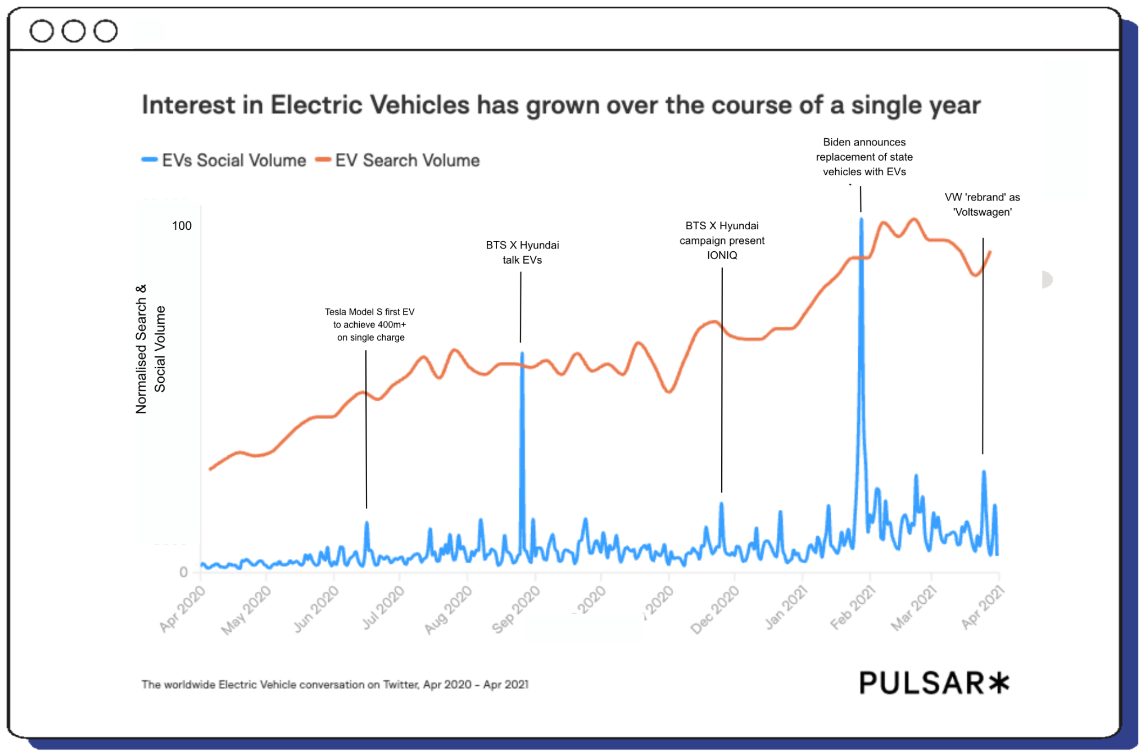
The graph above visualises the invaluable insights derived from this analysis. The blue line represents the normalised search volume for electric vehicles, while the orange line reflects social conversations surrounding EVs.
A keen observation reveals that while social conversation has steadily increased over the year, normalised search volume experiences dramatic spikes with significant events in the electric vehicle industry, such as new product announcements or key developments.
Using social listening tools like Pulsar TRAC, you can easily harvest these types of insights, offering indispensable knowledge to brands navigating this space. Whether you're an industry leader like Tesla, Hyundai, or Volkswagen or an emerging player in the electric vehicle market, understanding these trends is crucial in shaping your strategy and engaging in online conversation.
Here, we're going to explore the specific benefits that come with incorporating social listening into your marketing strategy:
1. Analysing audience sentiments through social listening
Social listening gives you access to a multitude of thoughts, feelings, and perceptions about your brand from your online audience. This knowledge allows you to align your marketing campaigns more closely with your customers' wants and needs, ultimately improving engagement.
2. Identifying emerging trends with social listening
As the digital landscape is ever-changing, ensuring your brand remains relevant and competitive is essential. Social listening enables you to detect new trends and shifts in consumer behaviour so you can adapt your marketing strategy accordingly.
3. Social listening for competitive analysis
Social listening also allows you to monitor your competition, providing insights into their strengths and weaknesses. Taking the time to understand your competition and where their successes lie becomes an opening for you to capitalise on opportunities to gain a competitive edge and eventually outperform those in your industry.
4. Leveraging influencers through social listening
Social listening helps identify potential influencers and key opinion leaders within your niche. Collaborating with these individuals who carry a large share of voice online can significantly extend your brand's reach and impact.
5. Crisis management and social listening
In many ways, social listening functions as an early warning system - allowing you to detect and respond to negative sentiments or brewing controversies before they escalate further. This proactive approach can help to prevent potential damage to your brand's reputation by acting fast and understanding consumers' pain points.
7. Social listening for product development
Use social listening to gather direct feedback and suggestions from your audience or customers. Learning what consumers think about your brand or products can inform your product development process to meet your customer’s evolving needs and wants. You can make specific changes based on actual public discussions online.
In summary, social listening gives you a more comprehensive understanding of your brand's presence in the digital space. By harnessing this technique, you can refine your marketing strategy to align with your audience's preferences and behaviours, significantly enhancing your brand's overall success.
Read our Guide to Social Listening for more detail on what it means, and how to use it. Or, head to our blog post, ‘Social Listening, Insight and Strategy, in that order. 9 Key Takeaways’ - for all you need to know about crafting a fool-proof social strategy as a marketer.
The benefits of using social media monitoring tools
When considering your brand's online presence, responding quickly and effectively is crucial - and social media monitoring tools make this possible.
They offer a laser-focused way to keep an eye on the ebb and flow of your brand's image on social media, picking up real-time discussions and offering quick-fire ways to engage.
We'll now explore the specific benefits of social monitoring and how this strategy can contribute to your marketing success:
1. Superior CX with social monitoring
Social monitoring allows you to pick up on real-time detection of customer queries, concerns, or complaints. With this, implementing immediate and appropriate responses can improve customer satisfaction and loyalty, reflecting positively on your brand's reputation through an ability to eliminate issues escalating.
2. Reputation management through social monitoring
In harmony with aiding customer service satisfaction - by keeping a close eye on mentions and discussions about your brand, social media monitoring helps manage your online reputation. Quick action in response to negative comments can mitigate potential damage and demonstrate your brand's commitment to customer satisfaction.
3. Direct engagement using social monitoring
Social monitoring facilitates direct engagement with your audience. Responding to comments or resharing user-generated content from those who have interacted with your brand can foster a strong connection between your brand and its followers, enhancing community building.
4. Discovering user-generated content with social monitoring
Tracking brand mentions can lead marketers to valuable user-generated content, from a positive review to a shared experience or creative product use. Amplifying this content can drive authentic engagement and build trust with your audience, encouraging more users to take the leap and become customers.
5. Real-time market feedback through social monitoring
Monitoring social interactions around your brand, products, or services provides immediate market feedback. Social media monitoring can guide rapid adjustments in your marketing approach or product offerings to better match consumer expectations. When aided with the knowledge of what users say about your brand or product online, marketers can make evidence-based alterations to your products or services.
6. Tracking campaign performance with social monitoring
By closely monitoring interactions and engagement during marketing campaigns, you can track their real-time performance. Monitoring interactions and engagements help to identify successful elements to replicate and less effective content to revise in future initiatives.
Social monitoring provides an immediate and focused view of your brand's social media presence, allowing you to react quickly and appropriately to maintain a positive brand image, keep your audience engaged, and stay in tune with real-time feedback.
To listen or to monitor? Tailoring your strategy based on social listening vs social monitoring
When building your social media marketing strategy, the decision to listen or to monitor isn't a binary choice – it's a strategic decision that can significantly impact your brand's online presence. Here, we'll explore when and why you might lean towards social listening vs social monitoring.
When to apply social listening for broad insights
Social listening is your go-to when you're looking to gain a broader perspective.
It's about taking a step back, looking at the bigger picture, and using the gathered insights to inform your long-term marketing strategy. If you're hoping to get a handle on overall brand sentiment, understand emerging industry trends, or keep an eye on your competition, social listening comes into play. This technique isn't just for the here and now; it's a forward-looking approach, letting you anticipate changes and stay ahead of the curve.
To put this in context, let's continue our exploration of the online discourse around electric vehicles, or EVs. We can assess the rate of growth in interest by comparing the volume of Twitter mentions related to EVs and other pertinent subjects.
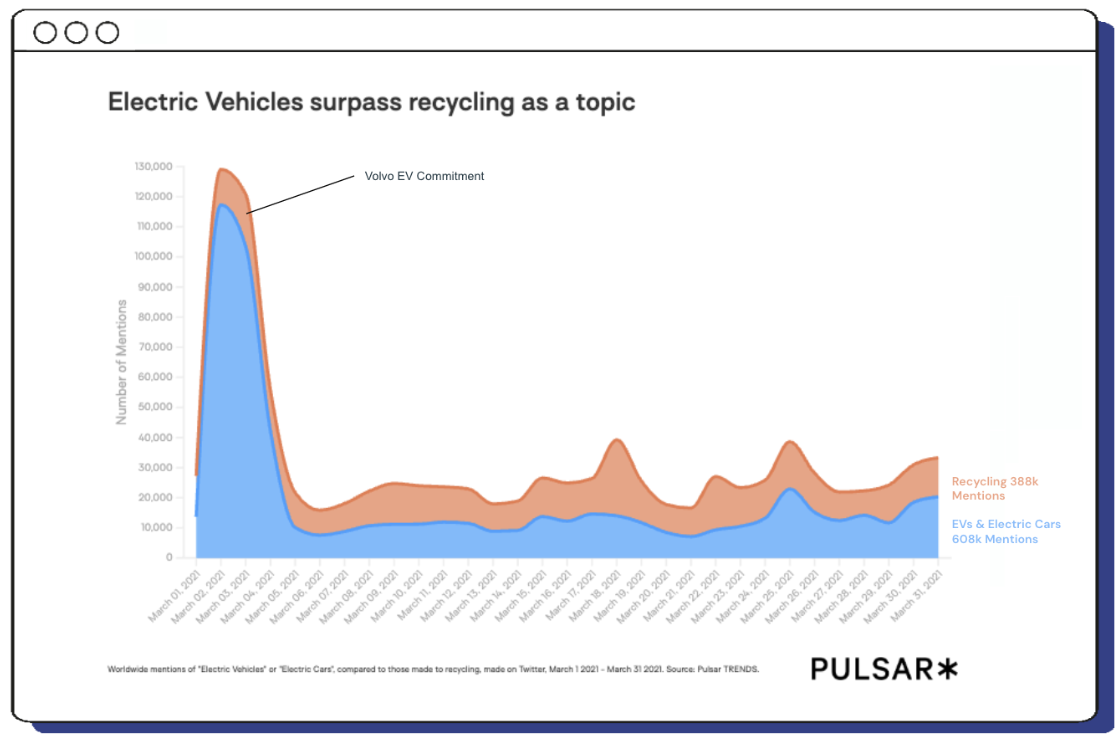
This approach is invaluable for anyone seeking to understand the ebb and flow of industry trends. To illustrate, we analysed the mentions of 'electric vehicles' and 'electric cars' against those of 'recycling' in March 2021. The results? EVs took the spotlight, racking up 608k mentions compared to 388k for recycling.
In this example, the takeaway is clear: social listening provides crucial insights for stakeholders in any eco-conscious sector. By keeping up with industry shifts, you can pivot your strategy to adjust to change and forecast future shifts - letting you stay a step ahead.
When to apply social monitoring for managing CX, reputation and reporting
On the other hand, social monitoring is your tactical tool for real-time, ground-level engagement.
When you need to react quickly to customer queries, manage your brand's online reputation, or track the performance of a live marketing campaign - think social monitoring. This approach is immediate and reactionary, allowing you to engage with your audience at the moment, solve issues as they arise, and foster a responsive and customer-focused brand image.
To cover all bases, maybe a combined social listening and social monitoring strategy is the best approach?
Is using a combined strategy of social listening and social monitoring the best for my brand?
While social listening and social monitoring offer different solutions to marketers looking to improve their social media presence or wider brand strategy, who said building your plan or action has to be founded upon one or the either for success?
Social listening and social media monitoring are most beneficial when used together.
Social listening sets you up for success, supporting marketers in creating a product, service or brand that resonates with its target audience. While social monitoring is effectively housekeeping to maintain that success, ensuring the brand stays visible and that customers experience positive interactions with it.
Utilise social listening for forming your longer-term solution, and social monitoring facilitating customer experience, reporting and your brand’s online reputation. By leveraging social listening and social monitoring together, you’re able to create content and campaigns that appeal to your audience base, by getting to know what people are talking about online within your field, while also retaining your loyal customers through quick interactions, giving your brand a human-like feel.
So, what is the best solution for building your brand marketing strategy? While a combination of social listening and social monitoring may seem like the most well-rounded strategy. It's time to reveal the game-changer - how you can transcend beyond both with the power of audience intelligence.
The limitations of using social listening and social monitoring in isolation: The need for a comprehensive approach
Despite their unique benefits, using social listening and social monitoring in isolation can limit the potential of your brand's strategy. Each plays a significant role in your marketing efforts, but viewing them as standalone approaches can mean missing out on a fuller, more integrated picture.
While social monitoring is invaluable for real-time engagement and reputation management, it can be somewhat short-sighted. Its focus on immediate interactions - although vital for CX - doesn't necessarily offer the broader perspective crucial for understanding significant trends and shifts in your audience's behaviours and attitudes.
On the other hand, social listening, although insightful for understanding audience sentiment and emerging trends, can overlook the importance of immediate, personalised responses that are often key in fostering a loyal customer base and a strong brand reputation.
So, what's the solution? A comprehensive approach is needed, one that goes beyond the individual merits of social listening and social monitoring.
Enter audience intelligence – a methodology that encapsulates both social listening and social monitoring while leveraging additional data and analytical techniques. Audience intelligence offers a holistic view of your audience's behaviours, preferences, and interactions, helping to inform strategic decisions and fine-tune your marketing efforts. It's the integrated approach your brand needs to understand your audience and create the content, campaigns, services or products they need to uplift your online presence.
Dive into the societal issues shaping online conversations about electric vehicles with this illustrative chart:
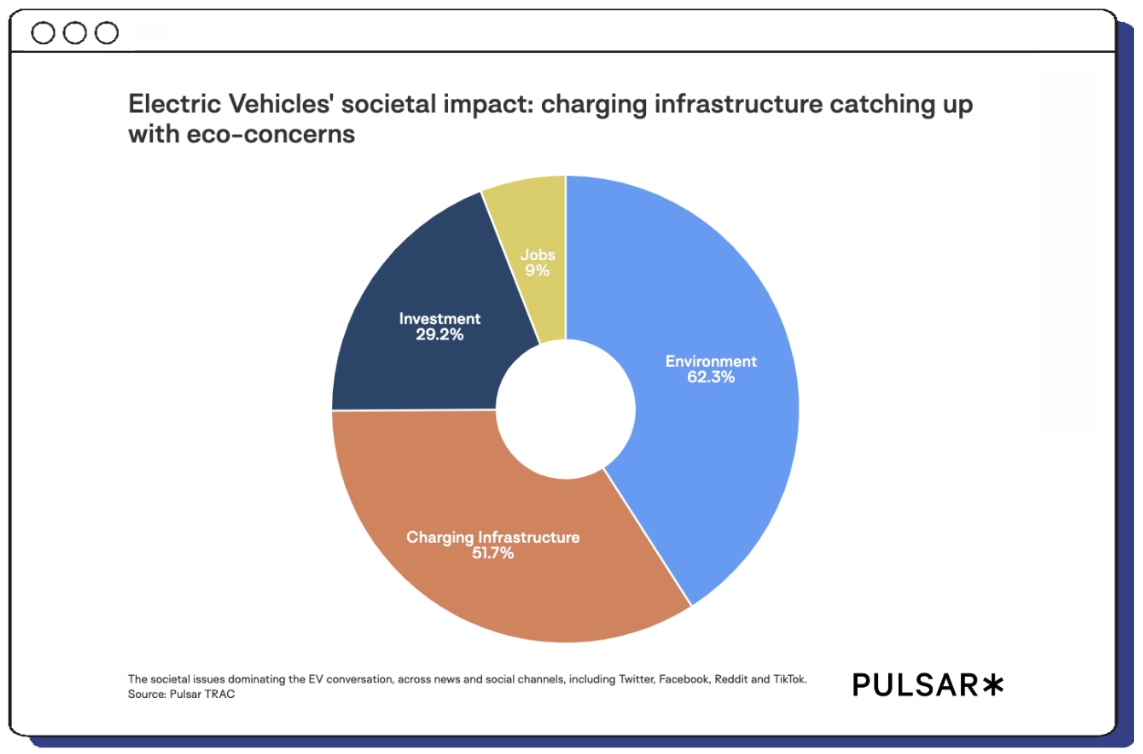
Comprehending these societal factors using social listening grants marketers crucial insights into the preferences, sentiments, and their audience's viewpoints on specific subjects of interest, including societal issues.
As the chart indicates, conversations about 'charging infrastructure' are rapidly closing the gap with environment-related discussions about EVs on social media platforms. This valuable information reveals what truly matters to an audience, enabling automobile providers to tailor their marketing and advertising strategies accordingly.
Read on as we explore how audience intelligence transcends the limitations of using social listening and social monitoring in isolation.
Beyond social listening vs social monitoring: Audience intelligence with Pulsar
Pulsar TRAC is an all-in-one tool providing the most comprehensive audience intelligence solution. Using Pulsar, you don't just get insight into what people are saying but why they're saying it. By leveraging cutting-edge AI technologies, Pulsar can analyse text, as well as images and emojis, giving you a much deeper understanding of your audience's conversations and sentiments.
What's more? Your analysis isn't limited to social media. Pulsar TRAC harnesses data from various sources, including blogs, forums, news articles, and reviews, to give you the broadest understanding of your audience possible.
With a focus on audience intelligence as your solution to brand marketing, connecting more effectively with your audiences, crafting messages that truly resonate, and fostering meaningful and lasting relationships are a reality for marketers.
How does audience intelligence differ from generic social listening?
While social listening provides invaluable insights, it's just the tip of the iceberg compared to the in-depth analysis offered by audience intelligence. As our understanding of audiences deepens, it's becoming clear that the need for more comprehensive tools is paramount. And Pulsar TRAC is where the concept of audience intelligence steps in, bridging the gap and providing more detailed audience insights.
Even still, it's necessary to acknowledge the value of social listening. Social listening remains an effective way to keep your finger on the pulse of public sentiment and to use that understanding to shape your messaging and marketing.
Audience intelligence, on the other hand, takes this to another level. It integrates social listening and social media monitoring, but it doesn't stop there. It delves deeper into your audience's world, holistically exploring their behaviours, preferences, and interactions.
For example, Pulsar TRAC allows you to gain a deeper understanding of user intent by tapping into Google search data using Pulsar TRAC. Through this analysis, you can uncover any questions and uncertainties consumers have about your product or service, ultimately capitalising on these insights to guide your strategy.
Let's take search queries that begin with 'can...'. These types of queries can reveal uncertainties or doubts that consumers may have, bringing to the surface questions you might not even be aware of, potentially revealing recurring themes, and offering valuable direction for your marketing strategy.
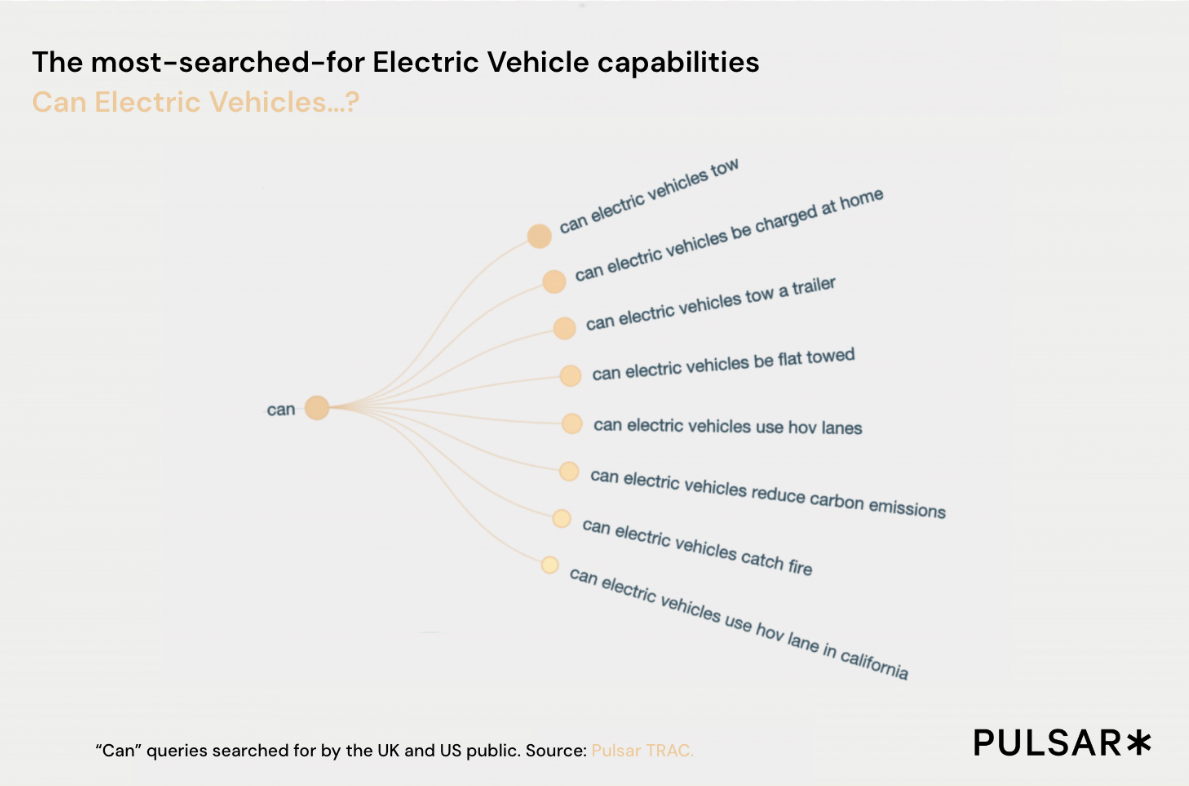
This chart shows the EV priorities for consumers based on their 'can' queries. As we see here, a majority of queries (58.2%) focus on the feasibility of charging an electric vehicle at home.
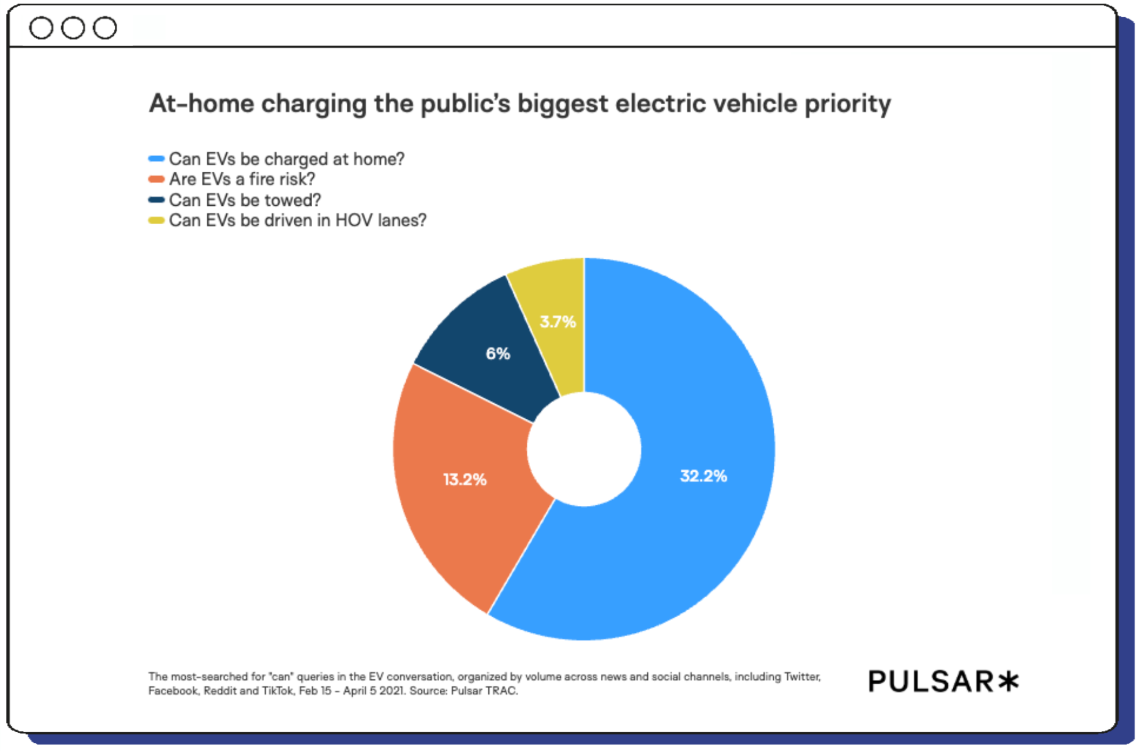
Such an insight isn't just interesting - it's actionable. It provides a clear direction for marketers and advertisers to develop content that addresses this specific concern, thereby helping to dissolve uncertainties and build consumer trust.
Pulsar TRAC provides more than just a snapshot of online conversation. It's about understanding the 'why' behind the chatter, identifying who's driving the conversation, tracing how these discussions evolve, and making sense of what it all means for your brand.
In essence, it's about transforming raw data into a rich, nuanced, and actionable understanding of your audience, enabling you to make more informed strategic decisions.
That's the power and edge of audience intelligence over generic social listening tools.
~
While we champion audience intelligence as the leading approach for deciphering audience behaviours and trends, it's undeniable to dismiss the relevance of social listening in today's digital landscape. Although social monitoring might seem limited when used independently, it's important to note that social listening and social monitoring are most effective when leveraged together rather than championing one as necessary for your strategic goals.
However, when we step beyond the dual use of social listening and social monitoring, it's clear that audience intelligence emerges as the superior method. It holds the potential to empower brands with profound insights and strategic foresight, leading the way in developing potent audience-focused strategies.
